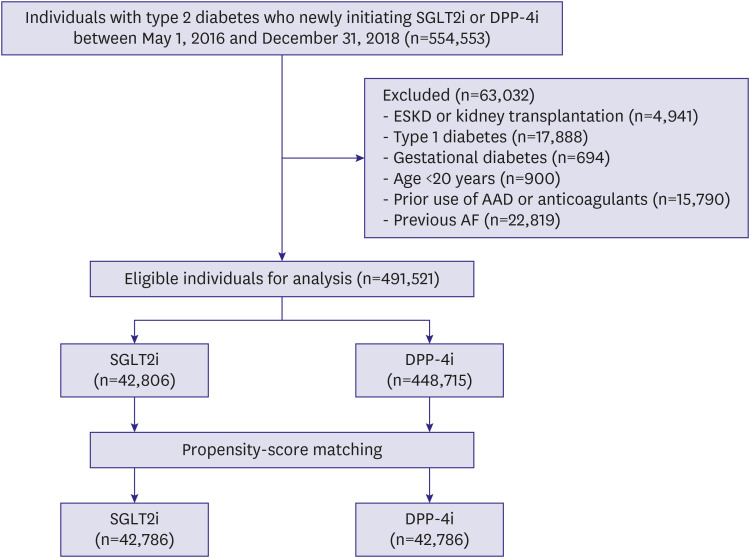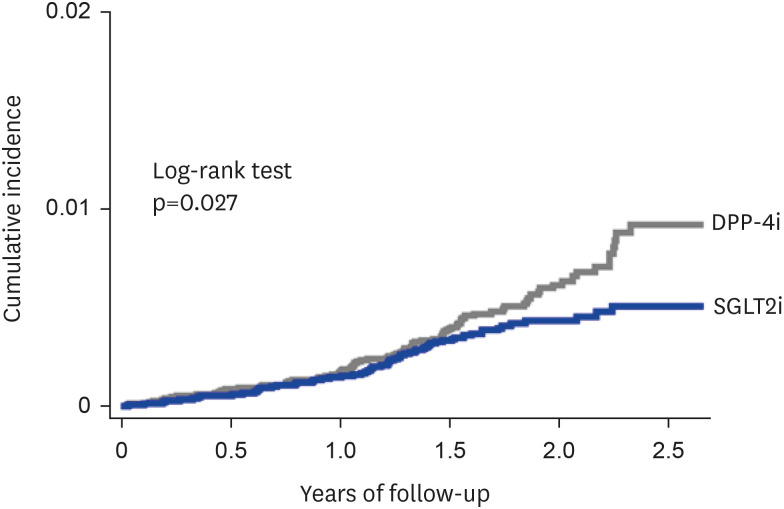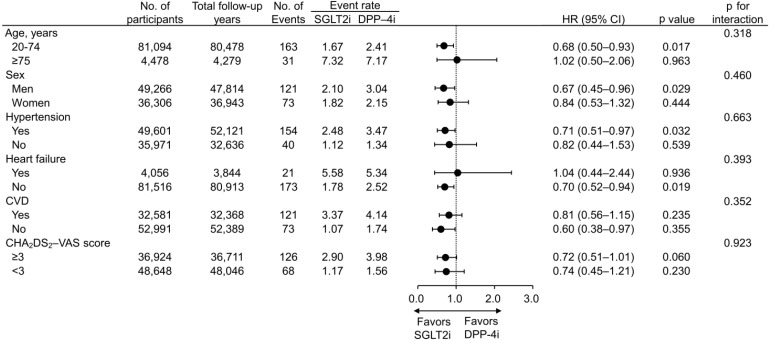Korean Circ J.
2024 May;54(5):256-267. 10.4070/kcj.2023.0234.
Lower Atrial Fibrillation Risk With Sodium-Glucose Cotransporter 2 Inhibitors Than With Dipeptidyl Peptidase-4 Inhibitors in Individuals With Type 2 Diabetes: A Nationwide Cohort Study
- Affiliations
-
- 1Department of Cardiology, Chungbuk National University Hospital, Cheongju, Korea
- 2Department of Endocrinology and Metabolism, Ajou University School of Medicine, Suwon, Korea
- 3Department of Cardiology, Chungbuk National University College of Medicine, Cheongju, Korea
- KMID: 2556522
- DOI: http://doi.org/10.4070/kcj.2023.0234
Abstract
- Background and Objectives
Accumulating evidence shows that sodium-glucose cotransporter 2 inhibitors (SGLT2is) reduce adverse cardiovascular outcomes. However, whether SGLT2i, compared with other antidiabetic drugs, reduce the new development of atrial fibrillation (AF) is unclear. In this study, we compared SGLT2i with dipeptidyl peptidase-4 inhibitors (DPP-4is) in terms of reduction in the risk of AF in individuals with type 2 diabetes.
Methods
We included 42,786 propensity score-matched pairs of SGLT2i and DPP-4i users without previous AF diagnosis using the Korean National Health Insurance Service database between May 1, 2016, and December 31, 2018.
Results
During a median follow-up of 1.3 years, SGLT2i users had a lower incidence of AF than DPP-4i users (1.95 vs. 2.65 per 1,000 person-years; hazard ratio [HR], 0.73; 95% confidence interval [CI], 0.55–0.97; p=0.028]). In individuals without heart failure, SGLT2i users was associated with a decreased risk of AF incidence (HR, 0.70; 95% CI, 0.52–0.94; p=0.019) compared to DPP-4i users. However, individuals with heart failure, SGLT2i users was not significantly associated with a change in risk (HR, 1.04; 95% CI, 0.44–2.44; p=0.936).
Conclusions
In this nationwide cohort study of individuals with type 2 diabetes, treatment with SGLT2i was associated with a lower risk of AF compared with treatment with DPP-4i.
Keyword
Figure
Reference
-
1. Hindricks G, Potpara T, Dagres N, et al. 2020 ESC Guidelines for the diagnosis and management of atrial fibrillation developed in collaboration with the European Association for Cardio-Thoracic Surgery (EACTS): The Task Force for the diagnosis and management of atrial fibrillation of the European Society of Cardiology (ESC) Developed with the special contribution of the European Heart Rhythm Association (EHRA) of the ESC. Eur Heart J. 2021; 42:373–498. PMID: 32860505.2. Movahed MR, Hashemzadeh M, Jamal MM. Diabetes mellitus is a strong, independent risk for atrial fibrillation and flutter in addition to other cardiovascular disease. Int J Cardiol. 2005; 105:315–318. PMID: 16274775.3. Bohne LJ, Johnson D, Rose RA, Wilton SB, Gillis AM. The association between diabetes mellitus and atrial fibrillation: clinical and mechanistic insights. Front Physiol. 2019; 10:135. PMID: 30863315.4. Wang A, Green JB, Halperin JL, Piccini JP Sr. Atrial fibrillation and diabetes mellitus: JACC review topic of the week. J Am Coll Cardiol. 2019; 74:1107–1115. PMID: 31439220.5. Newman JD, Vani AK, Aleman JO, Weintraub HS, Berger JS, Schwartzbard AZ. The changing landscape of diabetes therapy for cardiovascular risk reduction: JACC state-of-the-art review. J Am Coll Cardiol. 2018; 72:1856–1869. PMID: 30286929.6. Li HL, Lip GY, Feng Q, et al. Sodium-glucose cotransporter 2 inhibitors (SGLT2i) and cardiac arrhythmias: a systematic review and meta-analysis. Cardiovasc Diabetol. 2021; 20:100. PMID: 33962654.7. Usman MS, Siddiqi TJ, Memon MM, et al. Sodium-glucose co-transporter 2 inhibitors and cardiovascular outcomes: a systematic review and meta-analysis. Eur J Prev Cardiol. 2018; 25:495–502. PMID: 29372664.8. Braunwald E. Gliflozins in the management of cardiovascular disease. N Engl J Med. 2022; 386:2024–2034. PMID: 35613023.9. Cheol Seong S, Kim YY, Khang YH, et al. Data resource profile: the national health information database of the National Health Insurance Service in South Korea. Int J Epidemiol. 2017; 46:799–800. PMID: 27794523.10. Kim D, Yang PS, Jang E, et al. Increasing trends in hospital care burden of atrial fibrillation in Korea, 2006 through 2015. Heart. 2018; 104:2010–2017. PMID: 29666179.11. Saliba W, Gronich N, Barnett-Griness O, Rennert G. Usefulness of CHADS2 and CHA2DS2-VASc Scores in the prediction of new-onset atrial fibrillation: a population-based study. Am J Med. 2016; 129:843–849. PMID: 27012854.12. Overvad TF, Skjøth F, Lip GY, et al. Duration of diabetes mellitus and risk of thromboembolism and bleeding in atrial fibrillation: nationwide cohort study. Stroke. 2015; 46:2168–2174. PMID: 26152296.13. Park S, Lee S, Kim Y, et al. Atrial fibrillation and kidney function: a bidirectional Mendelian randomization study. Eur Heart J. 2021; 42:2816–2823. PMID: 34023889.14. Fatemi O, Yuriditsky E, Tsioufis C, et al. Impact of intensive glycemic control on the incidence of atrial fibrillation and associated cardiovascular outcomes in patients with type 2 diabetes mellitus (from the Action to Control Cardiovascular Risk in Diabetes Study). Am J Cardiol. 2014; 114:1217–1222. PMID: 25159234.15. Huxley RR, Alonso A, Lopez FL, et al. Type 2 diabetes, glucose homeostasis and incident atrial fibrillation: the Atherosclerosis Risk in Communities study. Heart. 2012; 98:133–138. PMID: 21930722.16. Seyed Ahmadi S, Svensson AM, Pivodic A, Rosengren A, Lind M. Risk of atrial fibrillation in persons with type 2 diabetes and the excess risk in relation to glycaemic control and renal function: a Swedish cohort study. Cardiovasc Diabetol. 2020; 19:9. PMID: 31954408.17. Bell DS, Goncalves E. Atrial fibrillation and type 2 diabetes: Prevalence, etiology, pathophysiology and effect of anti-diabetic therapies. Diabetes Obes Metab. 2019; 21:210–217. PMID: 30144274.18. Zelniker TA, Wiviott SD, Raz I, et al. SGLT2 inhibitors for primary and secondary prevention of cardiovascular and renal outcomes in type 2 diabetes: a systematic review and meta-analysis of cardiovascular outcome trials. Lancet. 2019; 393:31–39. PMID: 30424892.19. Zelniker TA, Bonaca MP, Furtado RH, et al. Effect of dapagliflozin on atrial fibrillation in patients with type 2 diabetes mellitus: insights from the DECLARE-TIMI 58 trial. Circulation. 2020; 141:1227–1234. PMID: 31983236.20. Shao SC, Chang KC, Lin SJ, et al. Favorable pleiotropic effects of sodium glucose cotransporter 2 inhibitors: head-to-head comparisons with dipeptidyl peptidase-4 inhibitors in type 2 diabetes patients. Cardiovasc Diabetol. 2020; 19:17. PMID: 32050968.21. Ling AW, Chan CC, Chen SW, et al. The risk of new-onset atrial fibrillation in patients with type 2 diabetes mellitus treated with sodium glucose cotransporter 2 inhibitors versus dipeptidyl peptidase-4 inhibitors. Cardiovasc Diabetol. 2020; 19:188. PMID: 33158436.22. Birkeland KI, Jørgensen ME, Carstensen B, et al. Cardiovascular mortality and morbidity in patients with type 2 diabetes following initiation of sodium-glucose co-transporter-2 inhibitors versus other glucose-lowering drugs (CVD-REAL Nordic): a multinational observational analysis. Lancet Diabetes Endocrinol. 2017; 5:709–717. PMID: 28781064.23. Lee MM, Ghouri N, McGuire DK, Rutter MK, Sattar N. Meta-analyses of results from randomized outcome trials comparing cardiovascular effects of SGLT2is and GLP-1RAs in Asian versus white patients with and without type 2 diabetes. Diabetes Care. 2021; 44:1236–1241. PMID: 33707305.24. Hu WS, Lin CL. Role of CHA2DS2-VASc score in predicting new-onset atrial fibrillation in patients with type 2 diabetes mellitus with and without hyperosmolar hyperglycaemic state: real-world data from a nationwide cohort. BMJ Open. 2018; 8:e020065.25. Alonso A, Krijthe BP, Aspelund T, et al. Simple risk model predicts incidence of atrial fibrillation in a racially and geographically diverse population: the CHARGE-AF consortium. J Am Heart Assoc. 2013; 2:e000102. PMID: 23537808.26. Li YG, Bisson A, Bodin A, et al. C2 HEST score and prediction of incident atrial fibrillation in poststroke patients: a French nationwide study. J Am Heart Assoc. 2019; 8:e012546. PMID: 31234697.27. Verma S, Mazer CD, Yan AT, et al. Effect of empagliflozin on left ventricular mass in patients with type 2 diabetes mellitus and coronary artery disease: the EMPA-HEART CardioLink-6 randomized clinical trial. Circulation. 2019; 140:1693–1702. PMID: 31434508.28. Scirica BM, Braunwald E, Raz I, et al. Heart failure, saxagliptin, and diabetes mellitus: observations from the SAVOR-TIMI 53 randomized trial. Circulation. 2014; 130:1579–1588. PMID: 25189213.29. Sinha B, Ghosal S. Meta-analyses of the effects of DPP-4 inhibitors, SGLT2 inhibitors and GLP1 receptor analogues on cardiovascular death, myocardial infarction, stroke and hospitalization for heart failure. Diabetes Res Clin Pract. 2019; 150:8–16. PMID: 30794833.30. Lee CS, Kim YG, Cho HJ, et al. Dipeptidyl peptidase-4 inhibitor increases vascular leakage in retina through VE-cadherin phosphorylation. Sci Rep. 2016; 6:29393. PMID: 27381080.31. Chang CY, Yeh YH, Chan YH, et al. Dipeptidyl peptidase-4 inhibitor decreases the risk of atrial fibrillation in patients with type 2 diabetes: a nationwide cohort study in Taiwan. Cardiovasc Diabetol. 2017; 16:159. PMID: 29258504.32. Kim D, Yang PS, Jang E, et al. 10-year nationwide trends of the incidence, prevalence, and adverse outcomes of non-valvular atrial fibrillation nationwide health insurance data covering the entire Korean population. Am Heart J. 2018; 202:20–26. PMID: 29802976.33. Liu X, Liu H, Wang L, Zhang L, Xu Q. Role of sacubitril-valsartan in the prevention of atrial fibrillation occurrence in patients with heart failure: a systematic review and meta-analysis of randomized controlled trials. PLoS One. 2022; 17:e0263131. PMID: 35081164.
- Full Text Links
- Actions
-
Cited
- CITED
-
- Close
- Share
- Similar articles
-
- Emerging Safety Issues of Dipeptidyl Peptidase-4 Inhibitors and Sodium Glucose Cotransporter 2 Inhibitors: How to Interpret and Apply in Clinical Practice
- Effect of Dipeptidyl Peptidase-4 Inhibitors on Cardiovascular Outcome
- Effect of Sodium-Glucose Cotransporter-2 Inhibitors versus Dipeptidyl Peptidase 4 Inhibitors on Cardiovascular Function in Patients with Type 2 Diabetes Mellitus and Coronary Artery Disease
- New Era for Renal-Protective Therapy in Type 2 Diabetes: Better Renal Outcomes in Patients with Type 2 Diabetes Taking Sodium-Glucose Cotransporter 2 Inhibitors versus Dipeptidyl Peptidase-4 Inhibitors
- Cardiovascular Safety of Sodium Glucose Cotransporter 2 Inhibitors as Add-on to Metformin Monotherapy in Patients with Type 2 Diabetes Mellitus




